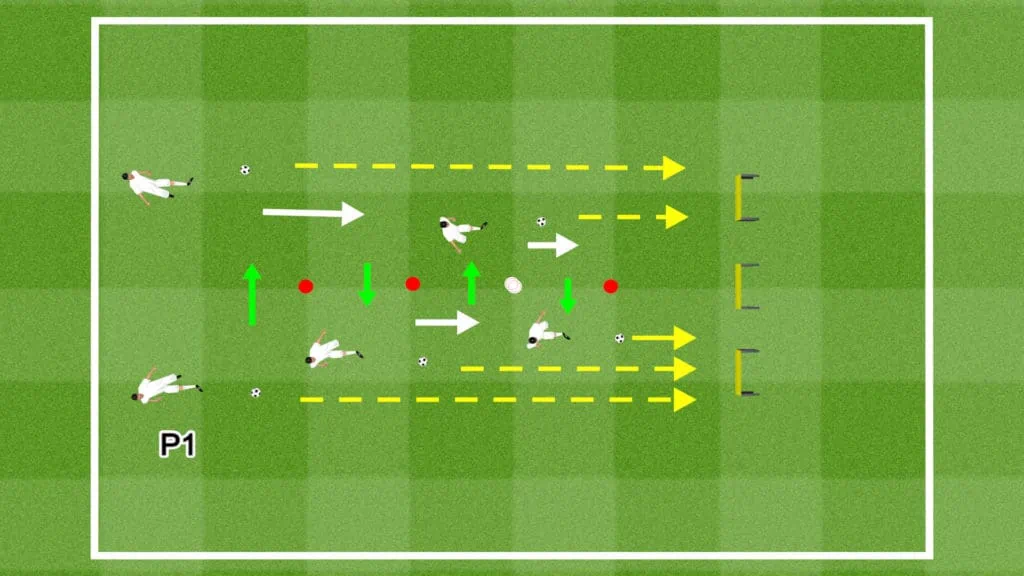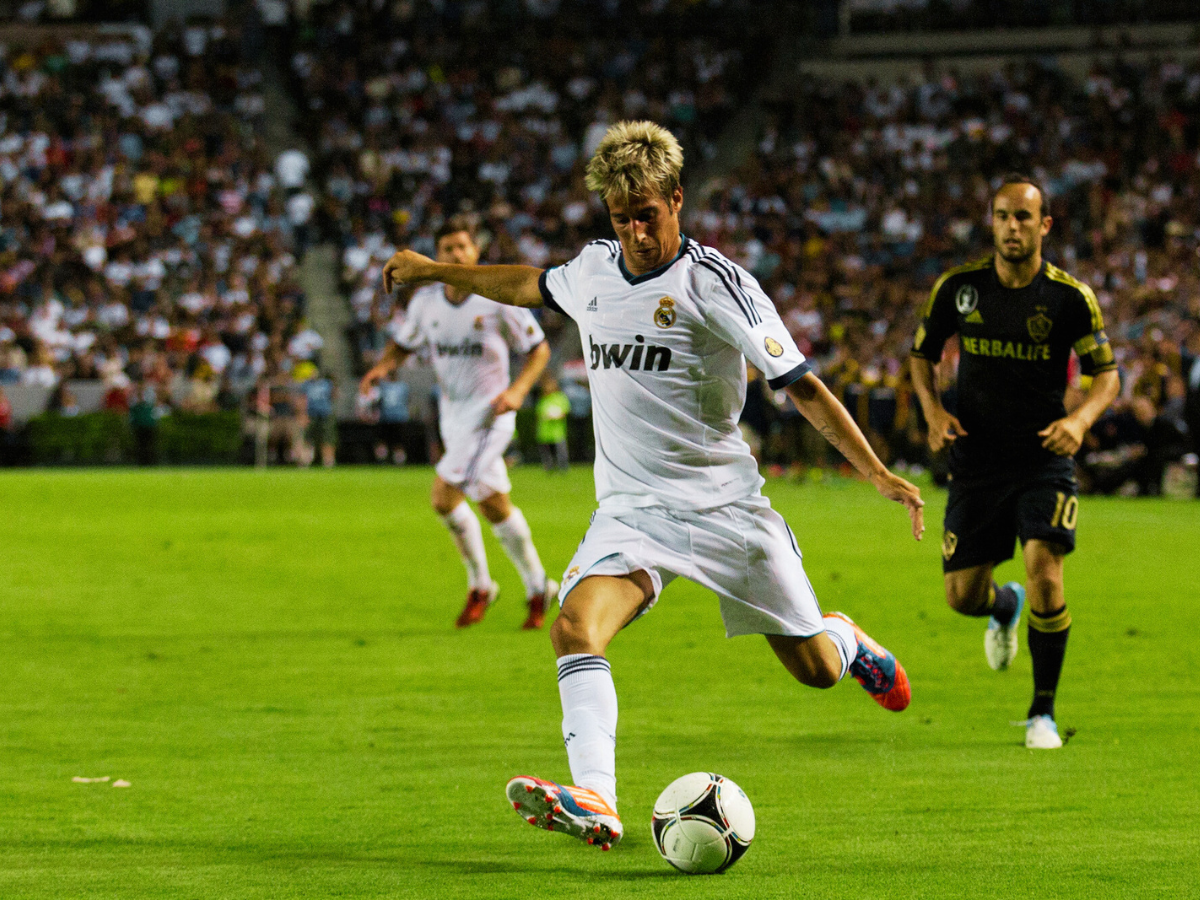Share the post "Ping a Soccer Ball: Mastering Precision Passing and Strategic Play"
In soccer, the term “ping” describes a type of pass that is not just a simple tap of the ball, but a sharp, driven pass that travels quickly to a teammate. Mastering the ping pass is can be the difference between maintaining the fluidity of play and losing possession. I’ve found that a well-executed ping can cut through defenses, release players into space, and set up scoring opportunities with its speed and precision.
When I train to improve my passing game, I focus on the technique required for pinging a ball effectively. It’s about striking the ball with the right part of the foot and following through perfectly. The situation on the field dictates when to use this type of pass. Whether I’m trying to switch the field of play or rapidly advance the ball up the field, recognizing the right moment to ping the ball is just as important as the execution.
During gameplay, the decision to ping the ball often comes down to the need for speed in transition. If I see a teammate making a run behind the defense, a swiftly driven ball to their feet is essential. It helps to exploit the spaces left open by opponents and keeps the energy of the game high. Understanding and applying the ping pass has definitely elevated my soccer skills, making me an asset to my team in high-pressure scenarios.

Basics of Pinging a Soccer Ball
Pinging a soccer ball is a precise skill that allows a player to pass the ball with pace and accuracy. I’ll guide you through its essentials to enhance this fundamental aspect of your game.
Watch out video on how to ping a soccer ball;
Understanding Pinging
When I talk about ‘pinging’ the ball, I’m referring to a way of striking it so that it travels quickly through the air to a teammate. For me, the key to pinging effectively involves hitting the ball with the instep of my foot, which provides both the power and direction necessary. It’s crucial that I plant my non-kicking foot beside the ball, pointing towards my target to maintain precision.
Ball Control and Touch
Before I even attempt to ping a ball, having a good first touch to control it and set it up for the pass is essential. I ensure that my body is over the ball to keep it under control. To develop my ball control and touch, I regularly practice trapping and maneuvering the ball with various parts of my feet. This foundational skill directly impacts the success of my pings.
The Approach to the Ball
The approach is all about positioning myself correctly before making a ping pass. I start by getting into the right body position — my standing leg is parallel to the ball, and my toes are pointed in the direction I want the ball to go. As I approach the ball, I focus on striking it with the laces of my boot, which means my ankle is locked and my foot is held firm. This offers me the stability and power needed to execute a clean strike.
Mastering the Ping Pass Technique
When I make a ping pass, it’s crucial for me to focus on body positioning, foot placement, and follow-through to ensure accuracy and power.
Body Positioning
I need to have my body facing the direction in which I want the ball to travel. I keep my knees slightly bent for balance and prepare my body to turn into the pass to generate more power.
Foot Placement
The placement of my foot on the ball is vital. I strike the ball with my instep, and I position my non-kicking foot close to the ball, pointing towards my target, to increase precision.
Follow-Through
After striking the ball, I emphasize the importance of a controlled follow-through. I make sure my kicking foot follows the direction of the pass to help maintain the ball’s trajectory and speed. I avoid over-rotation to stay balanced and ready for the next play.
Situations for Pinging the Ball
In soccer, accurately pinging the ball can be a game-changer. It creates opportunities and shifts the dynamics in our favor.
Switching the Field
When I see my team is crowded on one side of the field, I use a ping to quickly switch the field. This helps in spreading out the opposition’s defense and can open up space for a new attack on the flank that’s now less populated. A precise, diagonal ball across the field to a teammate gives us a tactical advantage.
Breaking Lines of Defense
Breaking lines of defense with a ping allows me to contribute to progressive play. For example, when a midfielder spots a forward’s run between defenders, a sharp, low ping can cut through multiple defensive lines and put the forward in a promising position. The key is timing and visibility – I must make sure my teammate is ready to receive the ball.
Long-Distance Communication
In situations where my teammate is making a run or is in a good position but out of shouting range, a long-distance ping serves as an effective means of communication. By sending a strong, aerial pass over distance, I can convey my intent and provide my teammate with the opportunity to take control in space. This requires precision to avoid interception and to land the ball where only my teammate can get to it.

Training Drills and Exercises
Developing the skill of pinging a soccer ball accurately involves a variety of drills that focus on improving your technique, precision, and timing. Let’s explore some effective exercises.
Solo Training Drills
Dribble and Ping: I start by dribbling the ball for 10 yards, then stop it and ping it against a wall. The objective is to hit a specific target area. I alternate feet every five attempts to develop both legs.
- Set up:
- 10-yard space
- Ball
- Wall with marked target
- Procedure:
- Dribble towards the target.
- Stop the ball.
- Ping it aiming for the target.
- Receive the rebound and repeat.
Long-Distance Pinging: I practice pinging the ball to distant targets set at various ranges, starting with 20 yards and increasing the distance as I improve.
- Gear needed:
- Cones to mark distances
- Multiple soccer balls
- Drill steps:
- Place the ball at the starting distance.
- Ping it towards the target.
- Retrieve and repeat, extending the range over time.
Partner Training Drills
Pass and Move Drill: My partner and I pass the ball back and forth with an emphasis on hitting a firm, low ping. We move to different angles and distances after each pass.
- Essentials:
- 1 partner
- Open space
- 1 ball
- Drill flow:
- One partner pings the ball.
- The other receives and pings back.
- Continue while changing positions.
Pressure Situations: We use a grid where my partner pressures me as I receive the ball. I aim to create space and ping a pass back to them or to a specified target zone.
- Setup details:
- 10×10 yard grid
- 2 players
- Ball and target zones
- Execution method:
- One player applies pressure.
- The other works to ping the ball accurately under pressure.
- Alternate roles regularly.
Team Scenarios
Possession Game under Pressure: My team circulates the ball in a small area under pressure, trying to maintain possession with quick, sharp pings.
- What’s needed:
- 8+ players
- Defined play area
- One soccer ball
- Playthrough:
- Establish teams in a small grid.
- Keep possession with sharp pings under pressure.
- Rotate the ball quickly.
Match-like Scenarios: Small-sided games with restricted touch counts force us to utilize pinging passes to maintain control and move the ball effectively.
- Preparation:
- At least 10 players
- Field divided into sections
- One ball per game
- Action steps:
- Split into two teams with limited touches.
- Focus on using ping passes to advance play.
- Implement match conditions to enhance realism.

Gameplay Applications
In the context of soccer, pinging the ball refers to passing with speed and precision to maintain the momentum of the game. This skill is essential for creating opportunities and disrupting the opposition’s formation.
Offensive Strategies
When I’m on the offensive, my aim is to break down the opponent’s defense. Pinging the ball allows me to:
- Enhance my team’s pace of play: Rapid and precise passes catch defenders off guard.
- Create space and chances: By pinging the ball into open areas, I facilitate quick runs and shots on goal.
Defensive Considerations
Defensively, pinging isn’t just about clearance. It’s about strategic positioning and control:
- Regaining possession: I use sharp passes to intercept and quickly distribute the ball to my teammates.
- Counter-pressing: When I lose the ball, a quick ping pass can disrupt the opponent’s counter-attack and allow us to reorganize.
Quick Transitions
In moments of transition, the ability to ping the ball accurately is crucial. Here’s how I capitalize on these moments:
- Switching the play: I can swiftly move the ball from one side of the field to the other, exploiting space behind advancing opponents.
- Fast breaks: By rapidly distributing the ball to forwards, I can maximize the potential of catching the opposition out of position.
Common Mistakes and Corrections
When I’m coaching players on how to effectively pass a soccer ball with a ‘ping’, I often see a few common errors. Identifying and correcting these mistakes early can dramatically improve a player’s passing game.
Overpowering the Ball
I’ve noticed many players assume that more power equals a better pass. However, overpowering the ball often leads to a lack of control and accuracy. To correct this:
- Focus on Technique: Use the instep (laces) and keep your ankle locked.
- Follow Through: Aim to have a controlled follow-through toward your target.
Miscalculating Angles
It’s not just about power; the angle of your pass plays a crucial role. If you get this wrong, your pass will likely go off course.
- Visualize the Path: Before passing, visualize the ball’s path and how it will reach your teammate.
- Adjust Your Body Position: Align your body to ensure the ball will travel along the intended path.
Inadequate Preparation
Players sometimes forget the importance of preparing their bodies before making a pass.
- Body Positioning: I make sure my body is square to the target, giving me a balanced stance.
- Awareness: I always check my surroundings to make the best decision for my pass.
Advanced Techniques
To elevate your game, mastering these advanced ping techniques will give you an edge over your opponents and improve your overall play.
Adding Spin
When I pass with a ping, adding spin can massively affect the ball’s trajectory and how difficult it is for opponents to handle. To generate topspin, I strike the upper half of the ball with a forward motion to make the ball dip faster, which is ideal in windy conditions. For backspin, I hit the lower half of the ball with an upward stroke; this is useful when I want the ball to hang in the air longer, often aiding my teammates in controlling my pass.
Pinging Under Pressure
Being able to execute a sharp, accurate ping pass when opponents are closing down space is crucial. I ensure my body is over the ball and my non-kicking foot is pointed towards my target. It’s important for me to stay calm and focused; I take a quick look up, visualize my target, and execute with a concise, swift motion through the ball.
Adapting to Weather Conditions
Different weather conditions require adjustments in how I ping the ball. In windy conditions, I keep my passes lower and stronger, often driving the ball with more force. In wet conditions, where the ball can skid, I use a softer touch, allowing the slippery surface to carry the ball at pace. For dry conditions with high grass, I add a bit more loft to ensure my pass doesn’t get slowed down significantly.
Incorporating Pinging into Match Play
In match play, I enhance my team’s performance by executing sharp, accurate pings at the right moments. These precise passes can change the dynamics of the game when done effectively.
Communication with Teammates
Before I send a pinged pass, I ensure there’s effective communication on the field. I make eye contact or use hand signals to confirm my teammate is ready for the pass. It’s vital that they’re aware and in a position to take advantage of my ping.
- Visual Cues:
- Eye contact
- Hand signals
- Verbal Cues:
- Quick calls (‘Time’, ‘Turn’, ‘Man on’)
Timing and Rhythm
I pay close attention to my team’s timing and rhythm when pinging the ball. I look for the natural ebb and flow of our movement to choose the perfect moment. A well-timed ping can exploit spaces and disrupt the opponent’s formation.
- Rhythm Indicators:
- Teammates’ movement patterns
- Gaps in opponents’ defense
Anticipating Opponent Movements
I always try to stay one step ahead by anticipating where opponents will move next. This allows me to adjust the direction and strength of my pings, thus keeping them out of reach of the opposing team. Predicting their movements also helps to maintain possession and control of the game.
- Prediction Factors:
- Opponents’ body language
- Opponents’ recent actions
When to Ping
Passing a soccer ball with a ‘ping’—a term denoting a sharp, quick pass—is a skill that elevates my game on the soccer field. It’s crucial for quick transitions in play and for keeping the opposing team on its toes. Whenever I ping a ball accurately to a teammate, it’s incredibly satisfying, and it also gives us a tactical advantage.
When implementing this technique in a match, timing and context are key. I ensure to assess when it’s appropriate to use a ping pass — typically when I need to get the ball to a teammate quickly over a distance, or when I’m trying to bypass the opponent’s midfield or defensive line.
Remember, the fundamentals are essential. Practicing a good stance, having a clear vision of the play, and striking the ball cleanly are all things I focus on to master the art of pinging the ball.
In summary, I always aim to:
- Sharpen my accuracy and power.
- Judge the right moment to use a ping pass.
- Maintain balance and technique when executing the pass.
Mastering the ping pass has become an integral part of my playing style, and it’s a tool I recommend every player adds to their skillset.
Share the post "Ping a Soccer Ball: Mastering Precision Passing and Strategic Play"
Joel is a seasoned soccer journalist and analyst with many years of experience in the field. Joel specializes in game analysis, player profiles, transfer news, and has a keen eye for the tactical nuances of the game. He played at various levels in the game and coached teams - he is happy to share his insight with you.



